Here we have two very different takes on technology and performance.
The Audi RS7 Sportback is a high-tech luxury four-door coupe with a stonking big V8 engine, and the Tesla Model S P85D is about the same size and shape, but makes do with batteries and two electric motors for its propulsion.
Why compare them? Simple â€" both are different answers to the same question.
That question is this: “What fast, high-performance, high-tech, comfortable large luxury sedan-slash-four-door-coupe should I buy with a quarter of a million bucks?â€
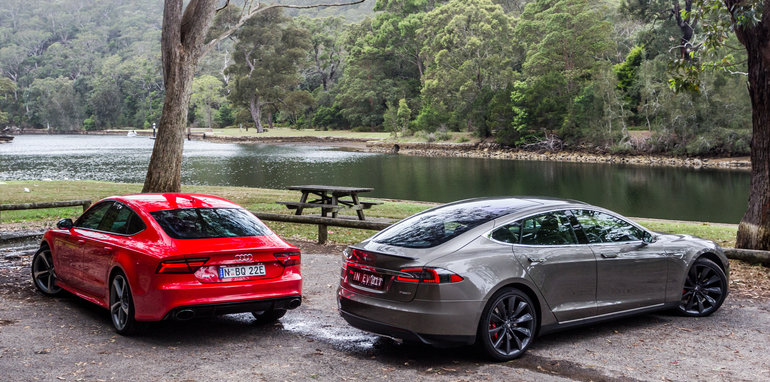
Let’s figure out which is the best answer.
Price and equipment
We’re talking pretty big bikkies for either of these two luxury sports sedans.
The Audi RS7 is priced at $242,000 plus on-road costs, which is a lot higher than the Tesla Model S P85D’s starting price, which ranges between $182,524 (in the ACT) and $193,956 (in WA) including on-road costs.
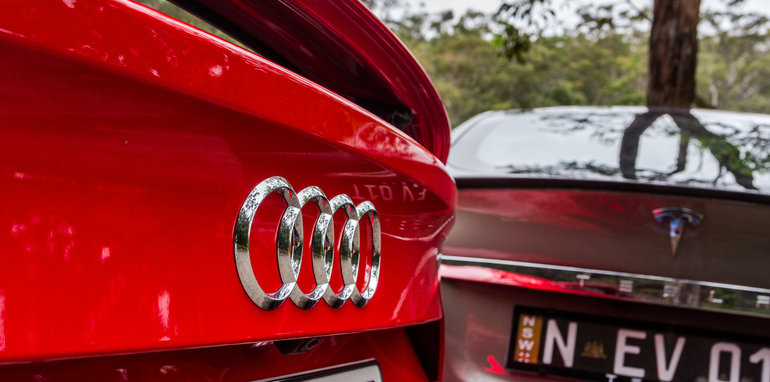
But when it comes down to specifications, the Audi offers a more inclusive take on things while the Tesla is options heavy.
Well, that’s not to say that you can’t option up the Audi, and indeed our car had the $25,840 Dynamic Package Plus arrangement, with ceramic brakes, ‘Dynamic’ steering, RS Sports suspension with adjustable dampers (replaces the standard air suspension) and a top speed lift to 305km/h, as well as a $12,000 Bang & Olufsen stereo, and a black highlight pack with high-gloss finishes on the front spoiler, grille, mirrors and window surrounds for $2200.
The Audi, though, comes with standard 21-inch alloy wheels, adaptive air suspension (if you don’t option the Dynamic Plus pack), LED headlights and LED tail-lights, quad-zone climate control, a single-pane sunroof, electric front seat adjustment including driver’s side memory settings, an 8.0-inch media screen with satellite navigation, digital radio and television reception, and dual USB inputs.
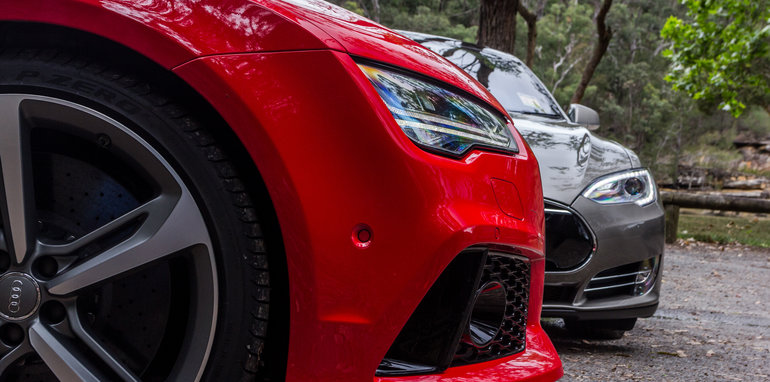
The interior of the RS7 comes trimmed as standard with quilted Valcona leather trim, and a flat-bottom sports steering wheel with paddleshifters. It also gets smart key entry and push-button start, as well as an electric tailgate.
All told, the RS7 represented here costs a whopping $281,650 plus on-road costs. Our P85D, as tested, is between $211,384 (minimum â€" ACT, on the road) and $224,692 (maximum â€" WA, on the road)… So, the electric car is a fair chunk cheaper than the optioned-up petrol-powered Audi.
Tesla has a concept of “build it how you want itâ€, and that means the Model S P85D â€" while cheaper â€" isn’t as well equipped at a glance.
For instance, the standard seats are trimmed with fabric inners, with leather adding $2500 and the (highly recommended) Next Generation seats with better bolstering taking that price to $3600. There is no sport seat option, though.
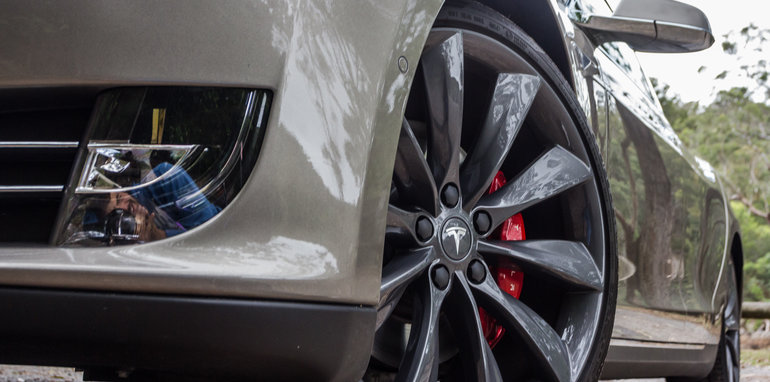
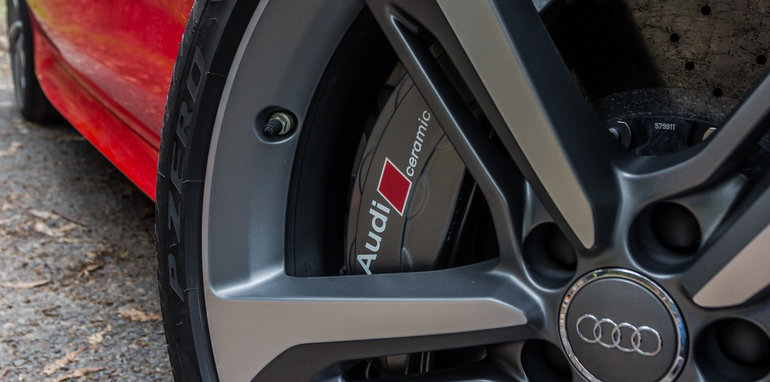
The dual-pane roof (with front opening section) is a $2100 option on the Model S, and it comes with smaller 19-inch wheels as standard (the “recommended†21s are a $6400 option â€" you get 21s standard on the Audi).
You do get a massive 17-inch media touchscreen with satellite navigation, dual USB inputs and internet radio, but you can’t get quad-zone climate control, nor is digital radio or TV available. Also, it’s worth noting that the headlights of the Tesla are xenon units, not LEDs, but the tail-lights are LEDs.
Premium paint is an option on the P85D, with five options including the Titanium Metallic you see here costing $1450, and two Multi-Coat finishes (Pearl White and Red) pushing that up to $2100. There are also two solid colours at no cost (White and Black).
Audi offers one solid paint finish at no cost (Nardo Grey), while there are three metallic finishes and three pearl effect finishes (including Misano red, seen here, at no cost), while the two crystal finishes add $1190, and the matt grey paint finish is an astonishing $12,300.
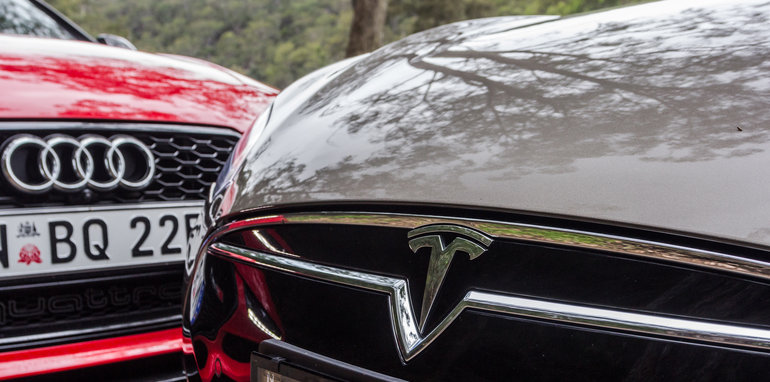
In terms of safety kit, the RS7 has eight airbags (dual front, front side, rear side, full-length curtain), front and rear parking sensors, and forward- and reverse-view cameras. Adaptive cruise control and a head-up display are standard, too, as is active lane assist and side assist.
The Tesla has dual front head airbags, dual front knee airbags and front side airbags, as well as full-length curtains, but no rear side airbags. It has front and rear parking sensors and a reverse-view camera, but no front-view camera, and no head-up display.
However, it does have extras such as blind-spot warning, autonomous emergency braking, lane departure warning, and, for those who option the Autopilot pack ($3600: everyone who buys a Tesla orders this, according to the brand) there are updatable safety features including radar cruise control, lane-keeping with automated steering, automated parking, and automated high- and low-beam headlights. These â€" and other goodies â€" can be updated remotely, using a Wi-Fi connection at your home.
When it comes to ownership, there are a few things to keep in mind.
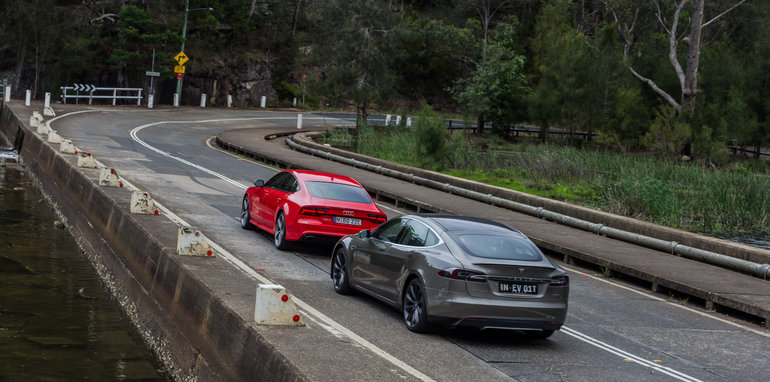
Firstly, fuel costs for the Tesla could be $0 if you charge using solar at home (though you need a home charging station, which costs a few grand, or you need to use Tesla’s Supercharger network, which may mean driving out of your way to charge quickly), whereas the Audi is going to set you back some cash. Like, probably a lot. If you’re filling up with $100 worth of juice every week in the Audi â€" entirely possible â€" you could spend $25,000 over five years on petrol alone. The Tesla may work out to cost you $0.00 over the same period.
But the biggest cost of ownership of any new car is depreciation, and Tesla has a guaranteed buyback program that spans three years and a maximum of 60,000km. The brand will purchase the vehicle back at a price of 50 per cent of the cost of the car and 43 per cent of all options fitted.
For most of its models Audi also has a guaranteed future value program that is packaged with its finance offering â€" but not for RS models or the R8 performance car.
Audi offers a three-year, unlimited-kilometre warranty for its cars, where Tesla has an eight-year, unlimited-kilometre warranty on its batteries and drive units, while the rest of the car is covered by a four-year/80,000km warranty.
Technology and connectivity
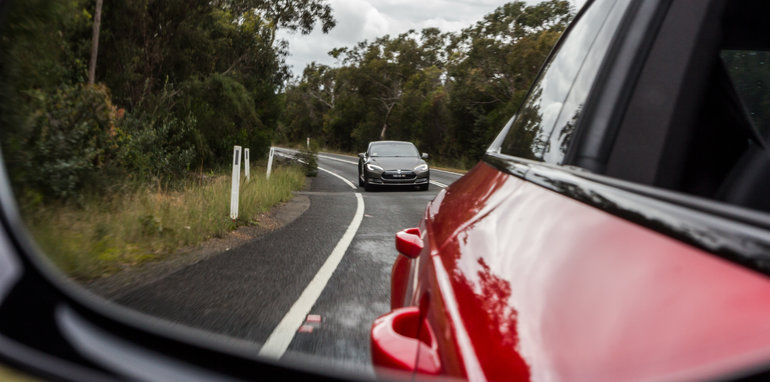
Obviously technology is Tesla’s game. In fact, you could refer to Tesla Motors as a technology company rather than a car company in conversation, and those listening would unlikely bat an eyelid.
It’s no surprise, then, that it shines in this sub-category.
The media screen is just the start. At 17 inches in diameter, it is likely much larger than the screen you’re reading this on, and it controls the vast majority of the car’s functions including aspects such as the driving modes, suspension height (for vehicles with the optional air suspension â€" $3200), heating, lights, navigation and sound system.
The Tesla has a built-in Telstra SIM card that covers your internet radio â€" which the Audi doesn’t have â€" for four years post-purchase. That SIM doesn’t get used for the ‘over the air’ updates, instead the car will use your home Wi-Fi connection to download new software.
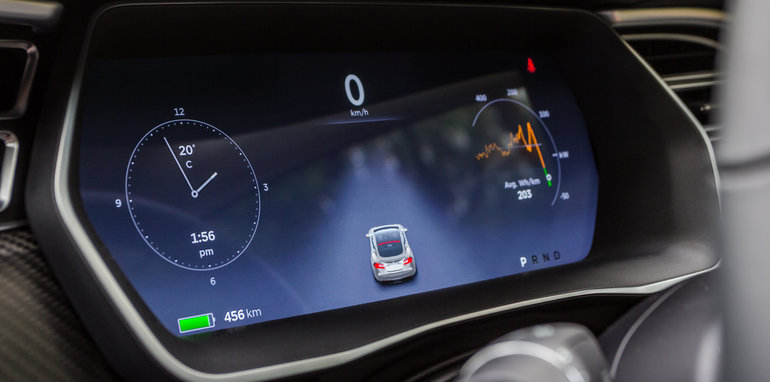
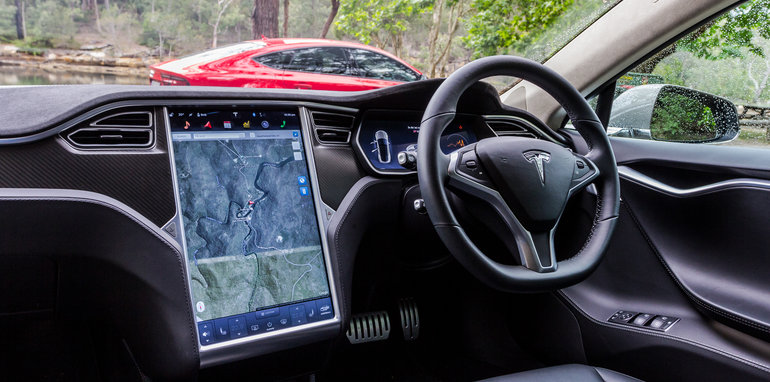
The updates include adjustments to the car’s Autopilot software, as well as other software changes for the media and dashboard displays.
Audi, too, is considered one of the most high-tech automotive manufacturers around, and while the screens aren’t quite as eye-catching, they are easy to use thanks to the German brand’s Multi Media Interface (MMI) system with its rotary dial and quick-hit buttons.
You really do notice how simple this is when you compare it against the Tesla, as it requires you to jump between screens somewhat, and there’s no hard buttons to quickly skip between steps.
The navigation, while more basic in terms of graphics in the Audi, doesn’t rely on 3G phone connectivity to load up the maps like the Tesla. That means you don’t get those awkward screen blank-outs when you’re out of phone range.
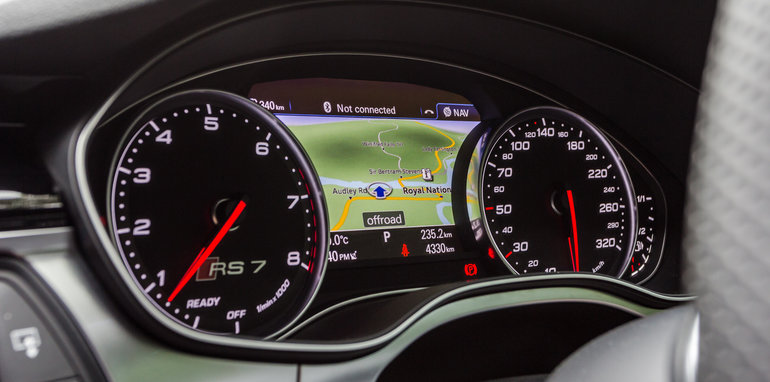
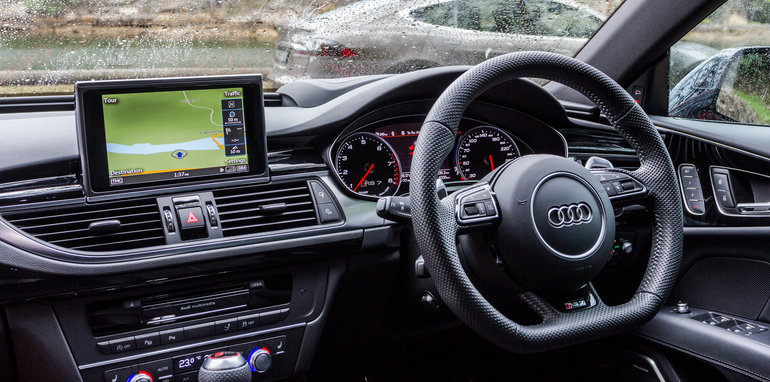
The RS7 has Audi Connect which can display Google Maps and Street View of the location you’re going to if required (which helps if you’ve never been to where you’re going, and you need to know what to look for). The system also allows you to insert a SIM or tether your phone to give the car its own Wi-Fi hotspot, with the upside that passengers can enjoy their time in the car as much as the driver (the Tesla can’t do that).
Cabin space and comfort
Both of these vehicles are pretty big.
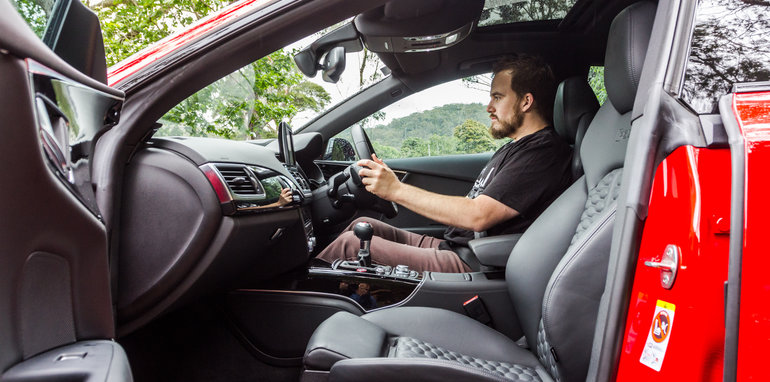
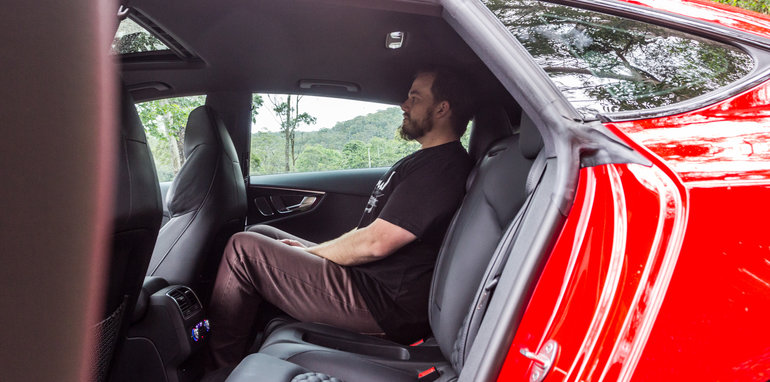
The Audi is 5012 millimetres long, 1911mm wide and 1419mm tall, and it rides on a 2915mm wheelbase.
The Tesla is a bit shorter, spanning 4976mm from front to back, but it is slightly wider at 1964mm, a touch taller at 1435mm, and has a longer wheelbase (2960mm).
You’d think, then, that these two would be very close on interior space and storage â€" but that’s not the case.
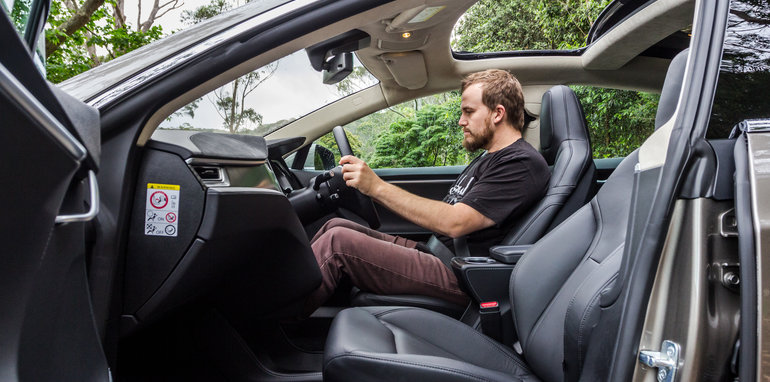
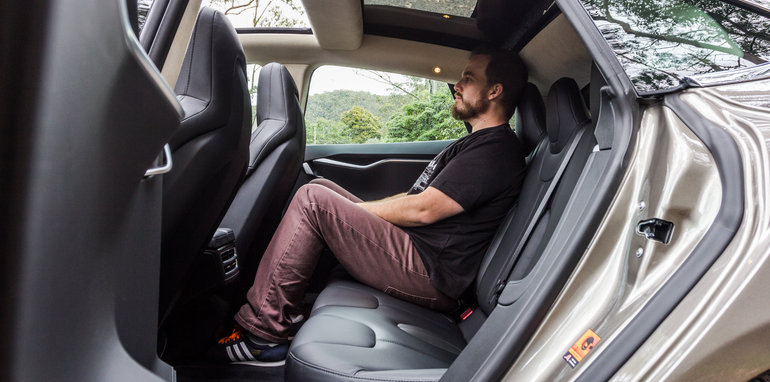
The Tesla’s underpinnings see the batteries packed in the wheelbase and the motors on the axles â€" and that means it has an abundance of cargo capacity at its disposal. The (would-be) engine bay has a cubby that can carry a pair of carry-on cases or your weekly shopping, while the boot is also big enough for several large suitcases, and it has a secondary storage hold under the floor. Total boot space is 745 litres, plus about 90L of frunk (front trunk)/froot (front boot) storage.
The Audi isn’t shamed into submission for storage, but it does fall well short. You can still easily fit a few suitcases or a set of golf clubs, but with 535L of cargo space it is hardly lacking luggage locale. If you really need extra space, you could choose the RS6 Avant station wagon, which is about $20,000 cheaper and has a further 30L of boot room. Most of the CA team think the wagon looks better, too…
It is worth noting that under the boots of both vehicles there are no spare wheels â€" both have repair kits only.
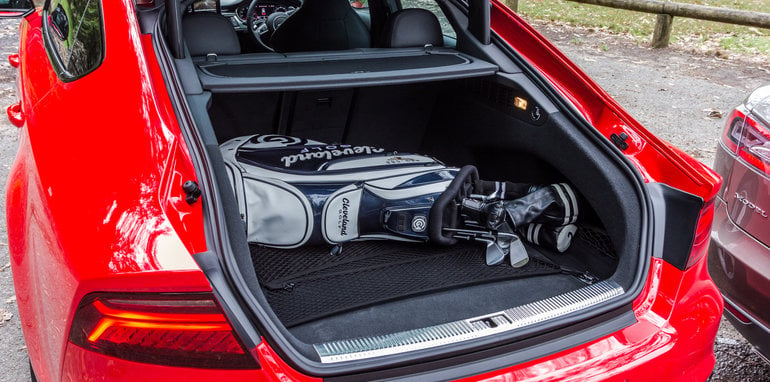
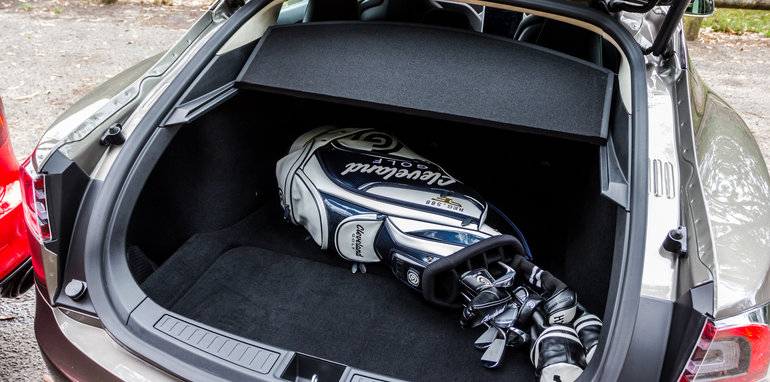
In terms of the cabin design, the Audi is perhaps more conventional, but it is certainly the more sports-oriented of these two, particularly with the multi-bolstered sports bucket seats easily offering better body support through corners than the Next Generation seats fitted to our Tesla.
That said, the biggest downer of the Audi’s cabin is that it is a four-seat layout only, where the Tesla has a more usable five-seat layout, albeit with a flat rear bench seat. Still, in the Audi all four seats are very comfy…
And the Audi nails the luxury brief better than the Tesla, too, with the RS7’s quality quilted leather trim and soft-touch finishes on all surfaces making it feel a more prestigious place to be. The Model S, by comparison, features leather that is not as elegant or well finished as in the Audi.
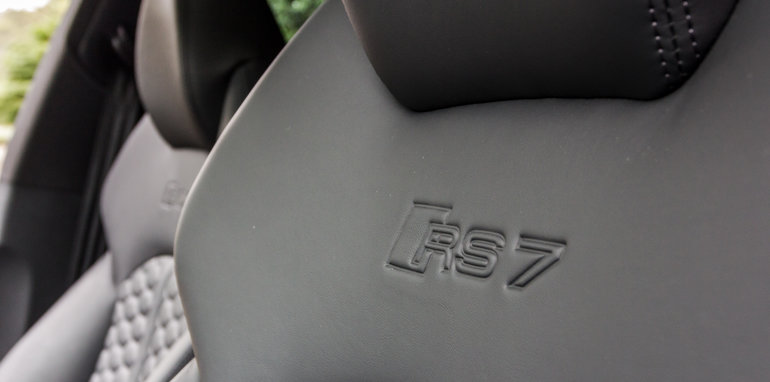
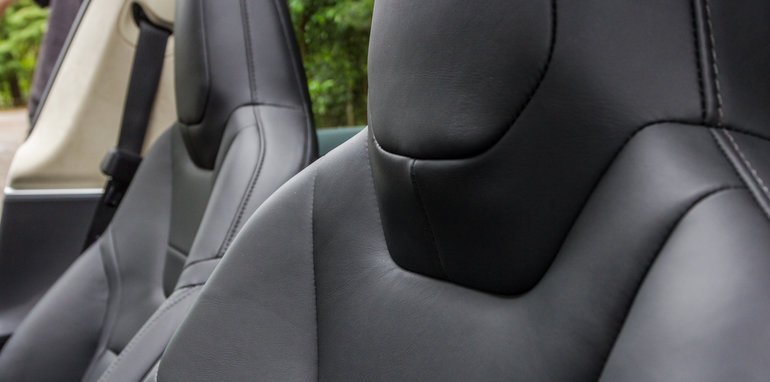
The rear seat space in the RS7 is somewhat cramped for tall adults in terms of headroom, and there’s not a lot of toeroom, either. Legroom, though, is decent.
The headroom in the Tesla is slightly better, kneeroom is similar, though toe space is tight. But the Model S’s rear seat is more of a knees-up position, with its shorter seat squab offering less support â€" however, the seats in the back of the Audi are positioned quite high, and the seat base could again be longer.
Further, the Tesla only has twin tunnel-mount air vents for those in the back, while the Audi has quad-zone climate control with quad vents for the back seat passengers, with low-mount tunnel vents and a pair of door pillar vents.
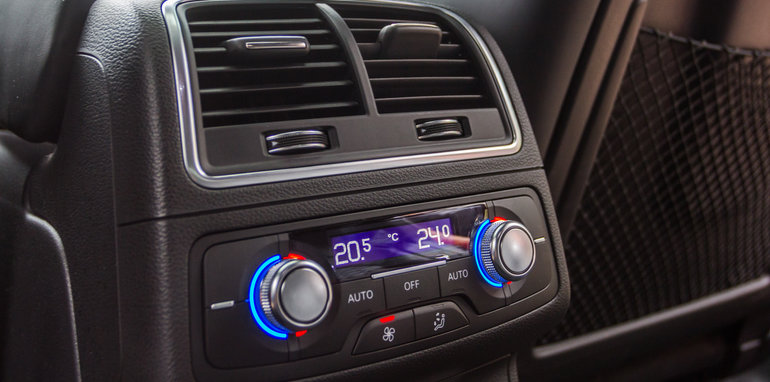
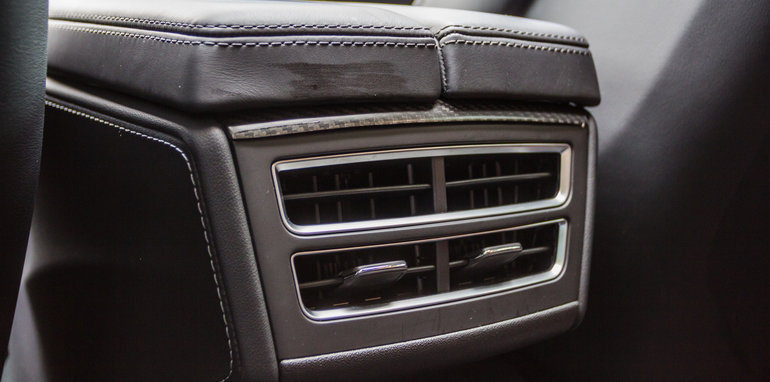
The Tesla also lacks any usable back seat storage. There are no map pockets or door pockets, but at least the floor is flat to allow for some handbag spots if required.
On the other hand, the Audi has shallow rear door pockets and mesh map pockets, and there’s a fold-down armrest with cupholders, and a ski port that the Tesla again can’t match.
Buyers with kids will appreciate that both models come with ISOFIX child seat anchor points.

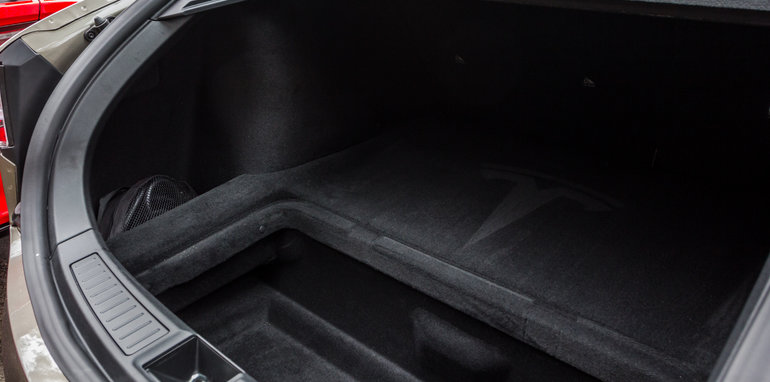
Up front the Audi also has decent door pockets with bottle holsters, and a high centre console bridge with cup holders. That flat-bottomed steering wheel is another likeable addition, and there’s also a digital television receiver to keep you entertained when the car’s at a standstill.
The Tesla doesn’t have a centre console bridge because it would get in the way of the big screen, and as such the centre cupholders are right where in-bound elbows would usually rest. And the lack of a storage box can be fixed by optioning the closable cabinet, but female buyers with big handbags may actually appreciate the middle section of the floor being clear (there’s a non-slip tray).
If you take the high-tech media screen and digital instrument cluster out of consideration, the Tesla falls a fair way short in the cockpit.
Performance and economy
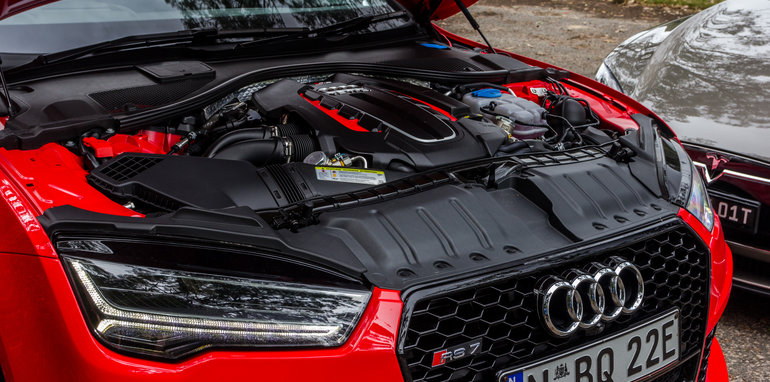
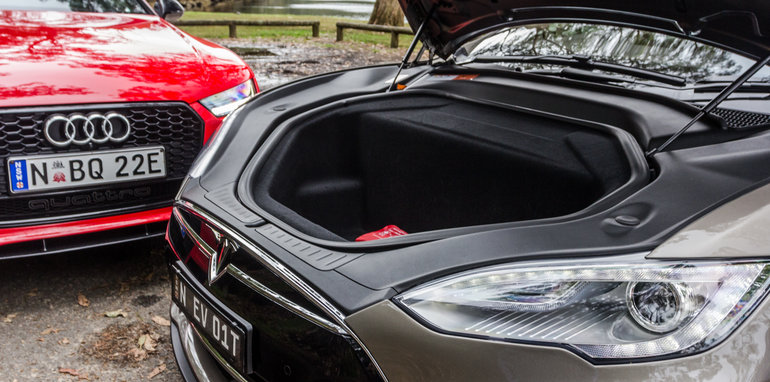
There’s a massive difference in the feeling you get when you’re driving a Tesla Model S P85D and pretty much any other car on the market.
The all-wheel-drive electric sedan with a motor at the front and another at the back is claimed to be the quickest sedan on the planet, with a claimed 0-100km/h time of 3.3 seconds in “Insane†mode.
It reaches highway speed from a standstill with a slingshot-style action that can be enough to give you a sore neck after a few attempts. You literally have to try and keep your head from being pinned back to the headrest, such is the mindboggling torque available from a standstill.
Indeed, there’s a huge 967Nm of torque available, as well as 568kW of power (193kW at the front wheels and 375kW at the rear).
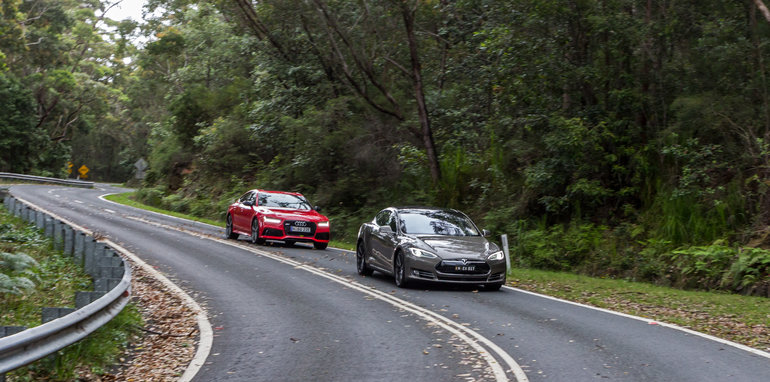
That’s much, much more than the already enormous figures of the RS7, which has a 4.0-litre twin-turbo V8 petrol engine producing 412kW and 700Nm. The power hits from 5700-6600rpm, and you ride the torque wave from 1750-5500rpm, so the delivery is brilliantly linear.
But the Tesla has all of its mumbo available from 0rpm â€" which means that you can rocket away much quicker, and with no lag (unless you have wheel spin, which can still happen despite it being all-wheel drive).
You’d probably think, then, that the Tesla has the Audi nailed for outright pace, and that’s certainly the case when it comes to straight-line speed. The RS7 has a claimed 0-100km/h time of 3.9 seconds, more than half a second adrift of the Model S P85D.
The visceral nature of the Audi’s propulsion, however, is magical. There’s so much calamity â€" from the noise of the V8 twin-turbo engine spooling up and spitting the car down the tarmac, to the vicious rumbling and crackle-popping from the exhausts on the over-run.
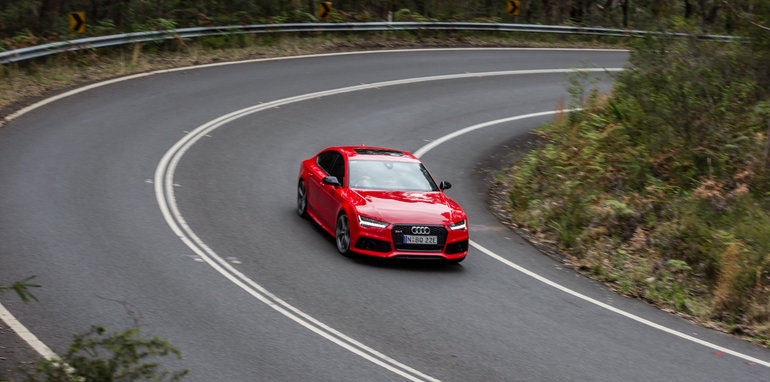
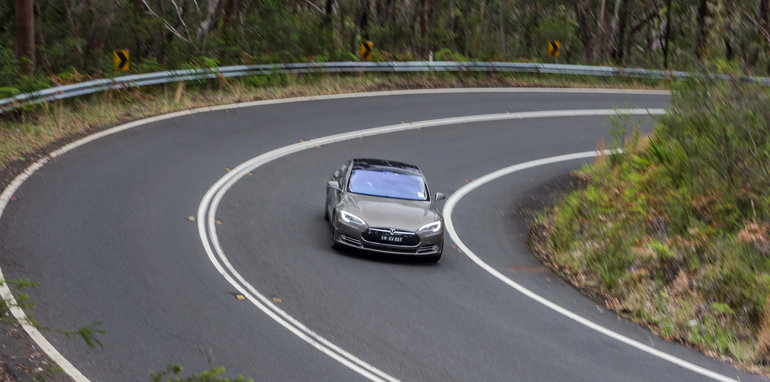
The fact you have eight gears to experience the raucousness of the engine across makes it all the more invigorating, though we experienced a couple of hard shifts and the occasional clunk through the drivetrain when getting off the throttle quickly. Further, in manual mode (which the Tesla doesn’t have!) the Audi felt a little slow to react at high revs.
The Tesla, on the other hand, with its reduction gear transmission, only offers up a remote control car-like electric whine. Or, as co-tester and former Melburnian Tim put it: “that electric noise is exactly like a tramâ€. The only thing that accompanies the whirr is wind noise and tyre roar, which is also evident in the Audi â€" albeit drowned out by that marvellous engine.
The range of each car is important, too. The Model S P85D claims electric driving range of 491 kilometres, and while Audi (and all conventional car makers!) don’t specify a range calculation, the RS7’s claimed combined cycle fuel use of 9.5 litres per 100km and a fuel tank of 75 litres means theoretically you should be able to cover 790km. But during our testing, it was much, much closer than that…
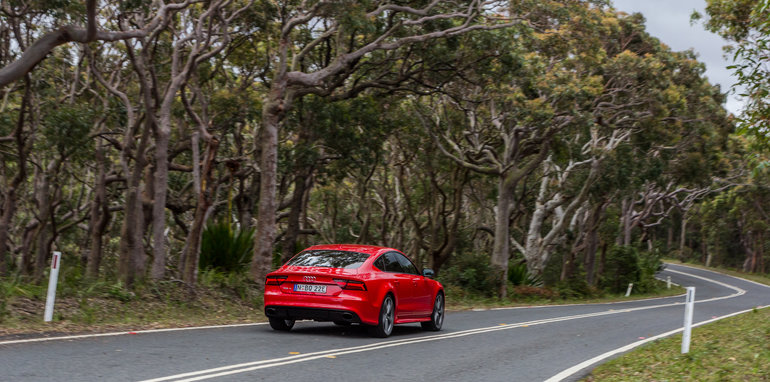
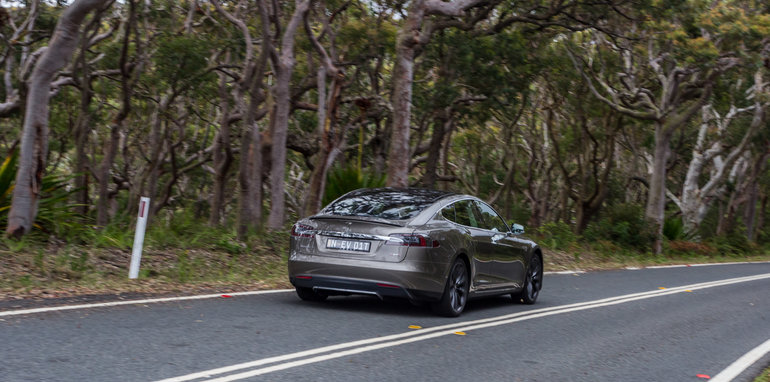
Indeed, we averaged about 14L/100km in the Audi across a mix of urban, country, cornering, and spirited driving, and our tank was down to a quarter after about 280km (90km to empty showing on screen). The Tesla’s energy consumption was on the high side, too, and after 280km it was getting pretty low (70km range remaining).
The difference is, however, that you can easily find a petrol station on the way to, well, almost anywhere.
At this point it’s still not so easy to find a Tesla Supercharger station to refill, but in case of emergencies there is a charge cable that can be plugged in to any powerpoint. Filling up isn’t a quick exercise in that situation, though, with the charge rate about 10km of range per hour of charging…
Ride and handling
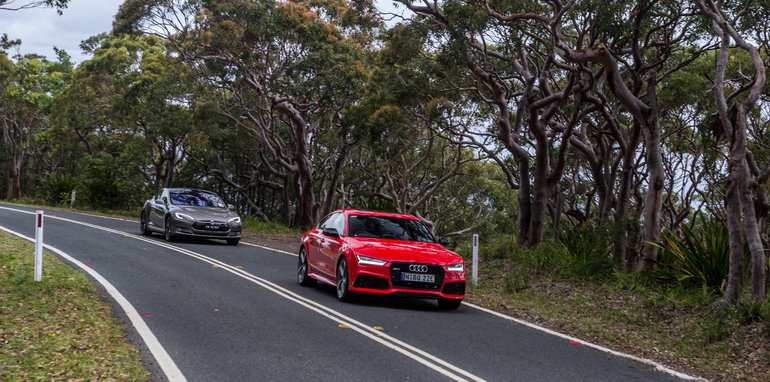
It is clear from the outset that the Audi has a more purposeful and sporty intent than the Tesla, despite the latter trouncing the former for straight-line speed.
RS â€" which stands for Renn Sport, or Racing Sport in English â€" is Audi’s utmost performance model line, and as such it’s no surprise that this model lives up to the hardcore expectations of buyers after a sleek four-door coupe with seriously impressive road manners.
Further, the Audi has a multitude of drive modes including Comfort, Dynamic, Auto and Individual settings, each of which is designed to change the behaviour of the car.
You can adjust the steering of the Tesla (Comfort, Normal, Sport) and the drivetrain response (Sport, Insane â€" and you can option a Ludicrous mode that boosts straight-line performance even more for about $20,000), but Tesla is not as all encompassing in its approach.
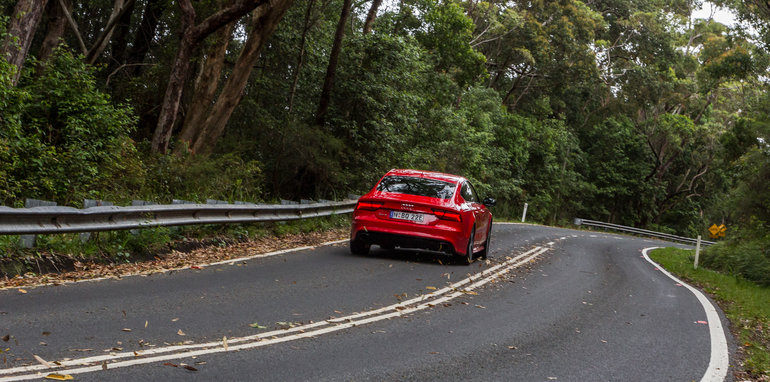
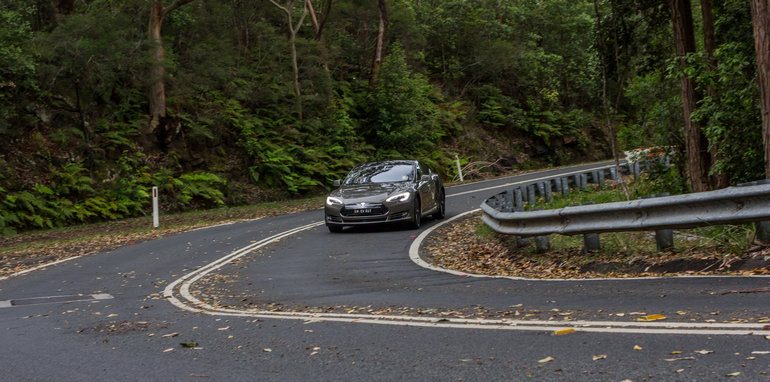
Being that the Tesla isn’t marketed or even considered as a sports model, where the Audi is, there’s good reason we found a bit of a go-fast gulf between these two.
Through corners the Audi rewards the driver a lot more than the Tesla, with its adjustable dampers (in Sport mode) allowing a tied-down feel that the Model S can’t match. That car’s air suspension doesn’t have a firmer setting to allow the driver to push harder, and as a result it is wobblier and less controlled through twisty stuff â€" the air suspension can only be lowered at low speeds, or raised to avoid nasty bumps, which is a bonus in the urban environment.
That air suspension, in combination with the Tesla’s extra weight â€" it tips the scales at 2187 kilograms while the Audi weighs in at 2005kg â€" makes the Model S feel less adept at hard and fast cornering.
As well as weight and the suspension, the Tesla’s steering impacts its performance as well. While both all-wheel-drive cars experience some understeer through tighter bends, the Audi bites down more aggressively thanks in part to its tyres.
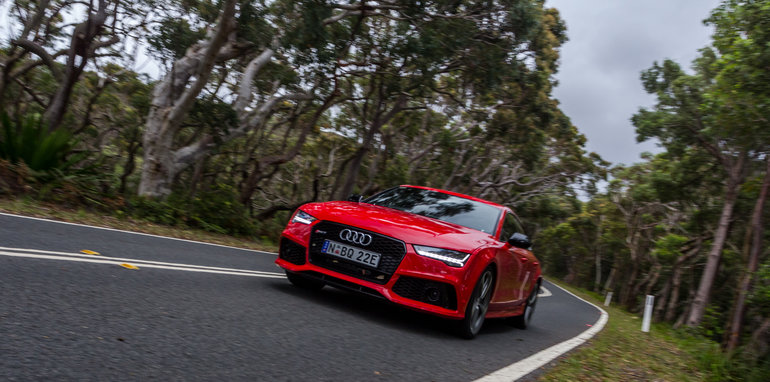
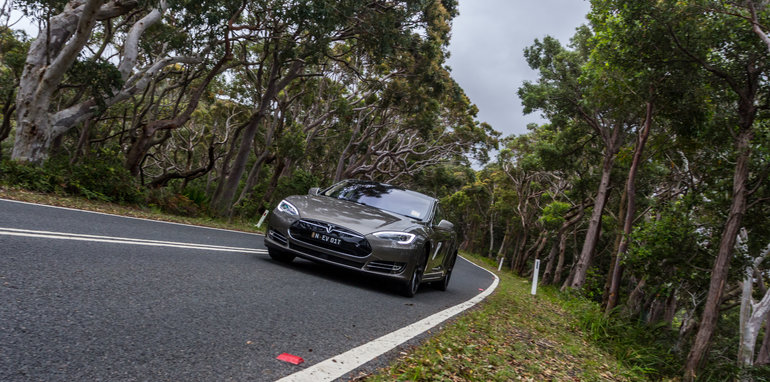
The Audi had 275mm, 30-profile tyres (oddly with Pirelli P-Zeros at the front and Continental ContiSport Contact 5Ps at the rear) which were notably broader and offered a better grip patch than the 245mm-wide, 35-profile Continental ContiSport Contact 5 rubber of the Tesla.
Still, the Audi is a lot firmer, though not uncomfortable, when it comes to dealing with bumpy sections of road. In fact, both Tim and I thought you heard the suspension dealing with the bumps to a greater extent than you felt the actual impacts.
Still, the ride in Comfort mode was somewhat wobbly, while in Dynamic it was firmer and a bit jittery, while the default Auto proved a good compromise in terms of cornering and comfort.
The Tesla offered a more enjoyable experience in most regards when it came to tooling around town.
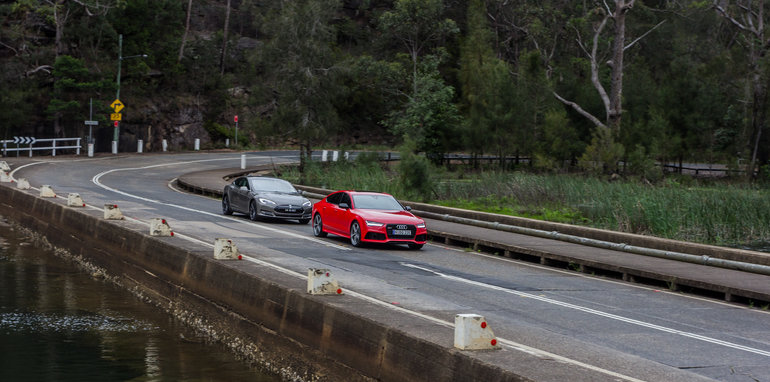
Its steering is lighter and more responsive at lower speeds, which allows for easier manoeuvring at intersections and such, though the suspension didn’t deal as well with bigger bumps as the Audi. It fell into potholes more heavily, though it did cocoon the cabin more over smaller bumps such as ripples.
The Tesla was also better over speed humps, with the suspension proving more comfortable but the airbags still lack some composure over bumps, and the nature of the Model S is to wobble a bit more.
Verdict
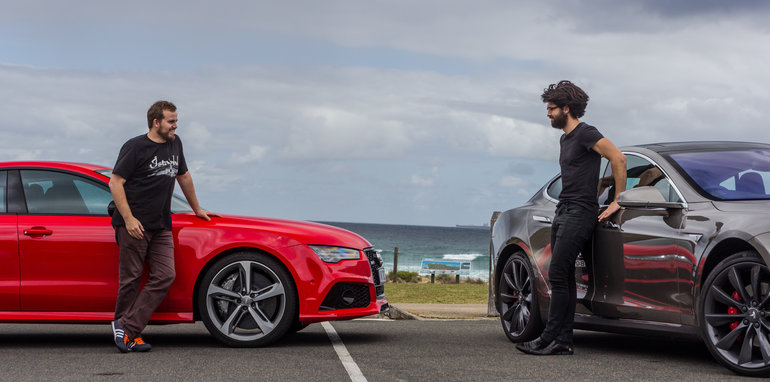
“What fast, high-performance, high-tech, comfortable large luxury sedan-slash-four-door-coupe should I buy with a quarter of a million bucks?â€
That’s the question this test set out to answer. And a clear answer is hard to come by.
The Tesla, for example, is more comfortable and has more straight-line performance, and has more technology.
It is a benchmark-setting car in many different ways. But…
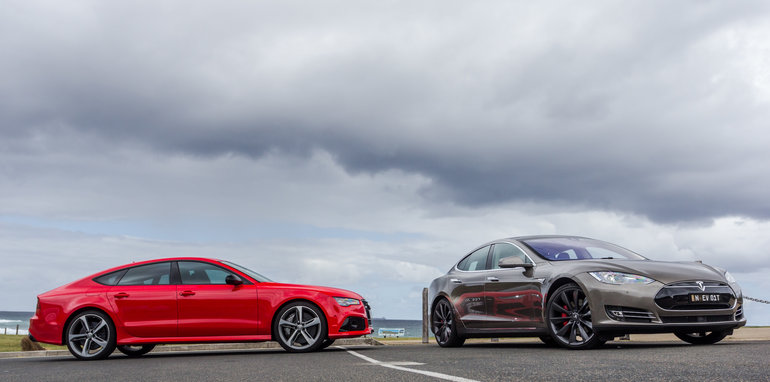
The Audi is a brilliant piece of machinery in its own right. It is more performance-oriented, and indeed delivers more completely on that criterion if corners matter to you.
It has some more high-tech elements than the Tesla, too â€" even though it is of the old school in that you can’t update it over the internet.
And it’s not uncomfortable, given its go-fast credentials.
And for that reason, the Audi RS7 Sportback answers the question a bit better than the Tesla Model S P85D in this very tight two-way test.
Click the Photos tab above for more images by Christian Barbeitos
Comments
Post a Comment